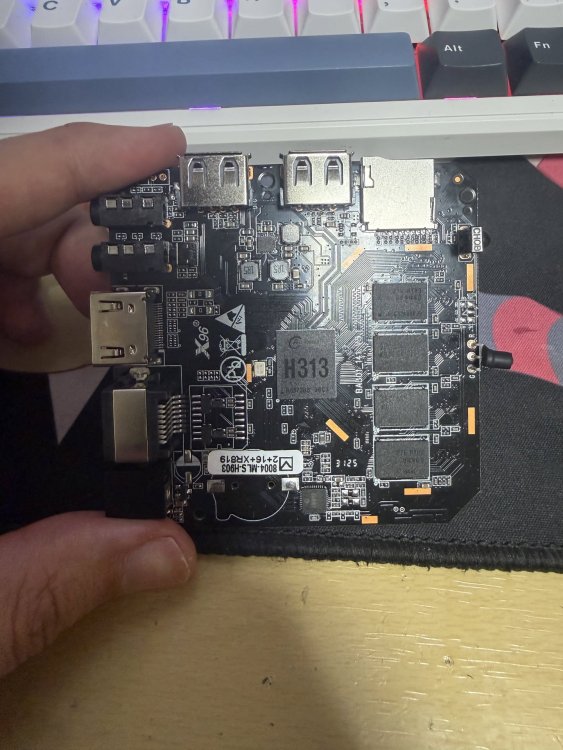All Activity
- Today
-

Armbian with preinstalled OpenMediaVault (OMV)
d1nuc0m replied to Igor's topic in Software, Applications, Userspace
Hi all, I just installed Armbian Linux v6.12 with OpenMediaVault (build date 2025/09/23) on a Odroid HC4. When I try to use apt update I get these errors Get:1 file:/var/cache/openmediavault/archives InRelease Ign:1 file:/var/cache/openmediavault/archives InRelease Get:2 file:/var/cache/openmediavault/archives Release Ign:2 file:/var/cache/openmediavault/archives Release Get:3 file:/var/cache/openmediavault/archives Packages Err:3 file:/var/cache/openmediavault/archives Packages Method gave a blank filename Get:3 file:/var/cache/openmediavault/archives Packages Err:3 file:/var/cache/openmediavault/archives Packages Method gave a blank filename Get:3 file:/var/cache/openmediavault/archives Packages Err:3 file:/var/cache/openmediavault/archives Packages Method gave a blank filename Get:3 file:/var/cache/openmediavault/archives Packages Err:3 file:/var/cache/openmediavault/archives Packages Method gave a blank filename Get:3 file:/var/cache/openmediavault/archives Packages Err:3 file:/var/cache/openmediavault/archives Packages Method gave a blank filename Get:3 file:/var/cache/openmediavault/archives Packages Err:3 file:/var/cache/openmediavault/archives Packages Method gave a blank filename Get:3 file:/var/cache/openmediavault/archives Packages Is this expected and related to Armbian setup or should I ask on OMV forum? -
Strange thing is that on Armbian Trixie (arm64), if I do 'apt install wireguard', I get as dependencies: linux-image-6.12.48+deb13-rt-arm64 linux-image-rt-arm64 wireguard-tools On vanilla Debian Tixie (arm64), only wireguard-tools Even if I remove/disable all armbian sources, same problem. Anyway the fix/cleanup that works for me (RK3588 platform): apt purge linux-image-6.12.48+deb13-rt-arm64 linux-image-rt-arm64 apt-mark manual wireguard-tools
-

mxq pro 4k 5g allwinner h313 can't sd card boot
Sergey Lepeshkin replied to Ducdanh Nguyen's topic in Allwinner CPU Boxes
@Ducdanh Nguyen, I don't understand how you could use electrical (insulation?) tape to connect to test points... Nevertheless, all you need is a good electrical contact between wires and test points. Means has no matter. Beware: signal levels is 3.3V. Do not connect directly to RS232 interface! What about flashing my modified update.zip - don't worry. It doesn't alter partition table, bootloader and backup partition. If something goes wrong, or you just want original firmware back - just connect power while holding button near "A/V" jack. This will start reflashing using your original update.zip, located in backup partition. If you want to extract your original update.zip from backup partition, simplest way to do this is using uart. Connect uart to pc, boot tv box normally, open serial port on pc (115200/8/n/1), issue 'su' command, mount /backup and copy /backup/update.zip anywhere you want. About laptop - I don't understand, how it's related to this discussion... If you want to compile armbian using it - go ahead. It doesn't matter what cpu architecture or type of memory it uses. All you need is correct toolchain, which suits our tv box SoC. -
merged. forum tag added.
-
I think I messed something up in the system, maybe with the repositories, but I get this message when updating... apt update Stary:1 http://deb.debian.org/debian bookworm InRelease Stary:2 http://security.debian.org bookworm-security InRelease Stary:3 https://download.docker.com/linux/debian bookworm InRelease Stary:4 http://deb.debian.org/debian bookworm-updates InRelease Stary:5 http://deb.debian.org/debian bookworm-backports InRelease Stary:6 https://dtcooper.github.io/raspotify raspotify InRelease Stary:7 https://github.armbian.com/configng stable InRelease Stary:8 http://armbian.lv.auroradev.org/beta bookworm InRelease Czytanie list pakietów... Gotowe Budowanie drzewa zależności... Gotowe Odczyt informacji o stanie... Gotowe 1 package can be upgraded. Run 'apt list --upgradable' to see it. root@orangepi3-lts:~# apt list --upgradable Listing... Gotowe armbian-bsp-cli-orangepi3-lts-current/bookworm 25.11.0-trunk.401 arm64 [upgradable from: 25.8.0-trunk.49] N: There is 1 additional version. Please use the '-a' switch to see it root@orangepi3-lts:~# apt list --upgradable -a Listing... Gotowe armbian-bsp-cli-orangepi3-lts-current/bookworm 25.11.0-trunk.401 arm64 [upgradable from: 25.8.0-trunk.49] armbian-bsp-cli-orangepi3-lts-current/now 25.8.0-trunk.49 arm64 [installed,upgradable to: 25.11.0-trunk.401] maybe someone has already dealt with this message and error?
-

CSC Armbian for RK3318/RK3328 TV box boards
sr4armbian replied to jock's topic in Rockchip CPU Boxes
Armbian Version: 6.12.56-current-rockchip64 TV Box: I have same board that is mentioned at this post. Issue: using the .dts mentioned in the above link I am able to see the clock with blinking separator. However I am not seeing the disk activity or LAN connections icon. If I am using devicetree changed to rk1188-box-led-conf-5, I can see the disk blinking icon and LAN connection, however the clock is not visible. Is there anyway I can get the clock as well the icons? Can you share the steps or the post that has the solution to this? -
Good to hear that it worked for you 👍. The PR on Github seems to be on a good way, so "official" support might be there soon...
-
There is no need to install "wireguard" as all Armbian images come with this kernel module by default. All you need is the userspace tools (if not installed already) from "wireguard-tools". If necessary try installing with "--no-install-recommends".
-
I have a raspberry pi running "Armbian 25.11.0-trunk.38 trixie" - I want to use this as a gateway, including running wireguard. When I install 'wireguard' and 'wireguard-tools' I receive this error: ``` Summary: Upgrading: 0, Installing: 0, Removing: 0, Not Upgrading: 2 2 not fully installed or removed. Space needed: 0 B / 27.9 GB available Setting up linux-image-6.12.48+deb13-rt-arm64 (6.12.48-1) ... /etc/kernel/postinst.d/initramfs-tools: update-initramfs: Generating /boot/initrd.img-6.12.48+deb13-rt-arm64 WARNING: Unsupported initramfs version (6.12.48+deb13-rt-arm64) - skipping setup NOTE: Manual boot configuration may be required /etc/kernel/postinst.d/z50-raspi-firmware: WARNING: Unsupported kernel version (6.12.48+deb13-rt-arm64) - skipping setup NOTE: Manual boot configuration may be required /etc/kernel/postinst.d/zzz-copy-new-files: cp: cannot stat '/usr/lib/linux-image-6.12.48+deb13-rt-arm64//overlays': No such file or directory run-parts: /etc/kernel/postinst.d/zzz-copy-new-files exited with return code 1 dpkg: error processing package linux-image-6.12.48+deb13-rt-arm64 (--configure): installed linux-image-6.12.48+deb13-rt-arm64 package post-installation script subprocess returned error exit status 1 dpkg: dependency problems prevent configuration of linux-image-rt-arm64: linux-image-rt-arm64 depends on linux-image-6.12.48+deb13-rt-arm64 (= 6.12.48-1); however: Package linux-image-6.12.48+deb13-rt-arm64 is not configured yet. dpkg: error processing package linux-image-rt-arm64 (--configure): dependency problems - leaving unconfigured Errors were encountered while processing: linux-image-6.12.48+deb13-rt-arm64 linux-image-rt-arm64 ``` It looks like the linux-image-6.12.48+deb13-rt-arm64 (6.12.48-1 package is trying to install an overlay in '/usr/lib/linux-image-6.12.48+deb13-rt-arm64//overlays' but that directory does not exist. The description of this package says: "This package depends on the latest Linux kernel and modules for use on 64-bit ARMv8 machines. " ``` ic linux-image-6.12.48+deb13-rt-arm64 6.12.48-1 arm64 Linux 6.12 for 64-bit ARMv8 machines (signed), PREEMPT_RT ii linux-image-current-bcm2711 25.8.2 arm64 Armbian Linux current kernel image 6.12.56-current-bcm2711 rc linux-image-rt-arm64 6.12.48-1 arm64 Linux for 64-bit ARMv8 machines (meta-package) ``` Any suggestions on how to resolve this? fastfetch output:
-
I just wanted to thank @Jojo for the hints and guidance - it works, my Armbian was directly installed onto my eMMC and booted right away, all seems to be working fine, I can move forward with my project. Really appreciated!
-

Rupa X88 Pro 13 - RK3528 board with images
CyberHaZard replied to fedes_gl's topic in Rockchip CPU Boxes
When I first flashed your latest image, the USB2 port did not work, only the blue port works. I then applied this overlay and after rebooting it now works. USB3 speed is still not functional. rk3528-x88pro13-usb2ndhost.dts rk3528-x88pro13-usb2ndhost.dtbo -

mxq pro 4k 5g allwinner h313 can't sd card boot
Ducdanh Nguyen replied to Ducdanh Nguyen's topic in Allwinner CPU Boxes
@Sergey Lepeshkin from the messages, i bought it online and the seller i know him since i bought wires from the shop. I couldnt contact the seller to provide the rom and i think they dont know since they most resell them. Also is it safe to install that file on my box?? Im scared that is going thr brick the box -

mxq pro 4k 5g allwinner h313 can't sd card boot
Ducdanh Nguyen replied to Ducdanh Nguyen's topic in Allwinner CPU Boxes
@Sergey Lepeshkin HOLYthat was the same color, same board layout i think mine is the same as you Btw im busy from school and my phone broke, it was a long time since… Also im not really into soldering can i use a electrical tape instead?? Edit : i have checked the modified version of the file, and the os, all the malwares are on my box i think we have the same box. I have a good specs laptop from 2018, it runs well and i can compile the image, the problem is the memory settings since i think we dont have the same ra, chips accord to the 2 years difference of the ram chip on my board -
I got interested after reading this thread and ordered an X96Q from AliExpress. The board is marked as V5.1, so I thought it would be straightforward, but after two days of trying, no matter which image I use, it always boots into Android. I tried UART communication, but nothing appeared. I even applied the secure boot patch and built it, just in case, but it still wouldn’t boot. How can I get this machine to boot from an SD card? I’m attaching photos of my board and the extracted DTS for reference. dtb.0.dts
-
I found a TX box X96 Mini with rk3228 chip and I try to boot with multitool but it is stuck with a red ligh. I try multitool and multitool2, with no success, can someone tell me what I am doing wrong ? Thank you The multitool i used are from here i used balena etcher to burn the image I also try to short pins on eMMc (around 45 times...) but nothing works from me. Now i order a male-male cable on amazon. edit: added front/left photos
-
@Jojo Would you be so kind and lend me a hand here? What I did: clone the repo locally manually changed the files in your PR (csc, dts and modified the .config) run ./compile.sh The problem is - it does not offer the M1S board in the list of targets. I must be missing a step or two. Would you mind checking my steps and advise, please? Never mind - all I needed to do is to click the middle option in the compile menu (Show CSC/WIP/EOS/TVB)
-
It sounds very promising for Espressobin usage and further kernels upgrades. It is yet to discover how could your u-boot port be built and which changes to code should be made for espressobin v5 and v7. I believe, they use the same chip. As you have a working build environment already, it would be worth sharing your pre-built binaries for testing in the 1st run. It could be a big step forward. Probably Armbian could offer them for downloads as well as alternatives in parallel with their own builds.
-
Debian would be even better, it just was not in your list. I'll then go and try to replicate your how-to, let's see if I can succeed
-
Different soc and even different soc family. This most likely will not work on h618.
-
Currently Noble Server is not planned. I have the impression, that generally speaking Debian is the way to go for server stuff while Ubuntu is more targeting Desktop systems (at least Armbian). Of course there might be cases where both are provided. All my small servers here at home run Debian-based systems. Never had any issues or disadvantages compared to Ubuntu... If you read through this thread, you'll see what is needed to build it on your own: - clone the Armbian repo - get the correct dts file and place it in the correct folder - get the correct csc file and place it in the correct folder - run the compile script and choose M1S from the list The files and where to place them can be found in the corresponding PR on github. If you don't get it running on your own just wait/hope a little bit for the board to be officially (community-)supported by Armbian. Or I share the pre-compiled image with you (on your own risk). Greetings
-
Step-by-step Guide to Install ILI9486 Display on Orange Pi Lite: 1.Create the overlay source file: cd /boot sudo nano spi-display-overlay.dts Paste your custom overlay configuration for SPI, DC, and reset GPIOs. 2.Compile the overlay to a binary (.dtbo) sudo dtc -@ -I dts -O dtb -o spi-display-overlay.dtbo spi-display-overlay.dts 3.Move the compiled overlay to the system overlays directory sudo cp spi-display-overlay.dtbo /boot/overlay-user/ 4.Enable the overlay in Armbian environment sudo nano /boot/armbianEnv.txt Add the line: overlays=spi-display-overlay 5. Reboot the system 6. Verify the framebuffer device is created: ls /dev/fb* Output should include /dev/fb0 7.Redirect framebuffer output to the SPI display sudo cat /dev/fb0 > /dev/fb0 It's just a test, it's a static image 8.Modify /boot/armbianEnv.txt Edit the armbianEnv file and add the following lines to ensure the framebuffer continuously updates on your display: extraargs=console=tty1 fbcon=map:0 fbcon=font:VGA8x8 usbstoragequirks=0x2537:0x1066:u,0x2537:0x1068:u ( 9.Troubleshoot reset GPIO if needed ) If display stays white, try another GPIO pin for reset in the overlay and recompile. Step 10: Post it on the Armbian forum and Reddit. I haven’t worked with the touch sensor yet, but it’s already 5 AM 0.o I hope this helps, and good luck!
-
Hi everyone! I thought I’d share my experience. I successfully got a display working on my Orange Pi Lite using this: https://github.com/jonathan-gatard/ili9486-xpt2046/tree/main I followed the instructions from the link above. At first, I connected the screen to the Pi and configured the pins in the device overlay. However, the reset pin, which was PD25, kept giving errors. Later, I rewired the display to a different pin, but it still didn’t work. Finally, when I moved it to a third pin, PC08, it worked! Until then, the screen just showed white, but after that, it started working perfectly. spi-display-overlay.txt
-

Gaming experience with Orange Pi 5 (RK3588) on Armbian
nom replied to KhanhDTP's topic in Orange Pi 5
This is truly incredible. I had no idea Mali and Linux has come this far. Though it's a shame things aren't mainlined. -

Orange Pi Zero 3 ili9486 TFT LCD (WaveShare 35a)
robertoj replied to goodfvh _YT_'s topic in Allwinner sunxi
Start with this DTS and change the GPIO for your OPIZ3 https://github.com/raspberrypi/linux/blob/rpi-6.12.y/arch/arm/boot/dts/overlays/piscreen-overlay.dts Or start with your DTS and change the "compatible" line to "compatible=waveshare,rpi-lcd-35" and copy the other parameters of piscreen-overlay.dts if needed Let us know if it works -
TV Box Status Information Template Version 1.0 TV Box Name (example: TX3 mini): T9 CPU (example: amlogic s905w): RK3328 Armbian build file name: Armbian_community_25.11.0-trunk.367_Rk3318-box_trixie_current_6.12.54_minimal.img DTB file used: rockchip/rk3318-box.dtb Kernel Version: 6.12.56-current-rockchip64 Distribution Installed (focal, buster, etc): trixie Working Ethernet (Yes/No):Yes Max Ethernet Speed that works (100/1000): 100 Max Does wifi work (Yes/No): Yes 2/5 Does bluetooth work (Yes/No): Yes Does HDMI audio work (Yes/No): Yes - after last update , (also analog and spdif ports are available - not tested). Additional Comments (provide any additional information you feel is important): IR Receiver yes 5 Digit display working: yes MASKROM PINS for recovery flashing available on the back side. SOC RK3328 RAM 4Gx4 D9PQL VFD DRIVER FD6551 WLAN CHIP SP6330 32 GB EMMc KLMBG2JENB VT RT9045 vfd.conf rk3318-t9.dtso Log android gpio T9.txt












